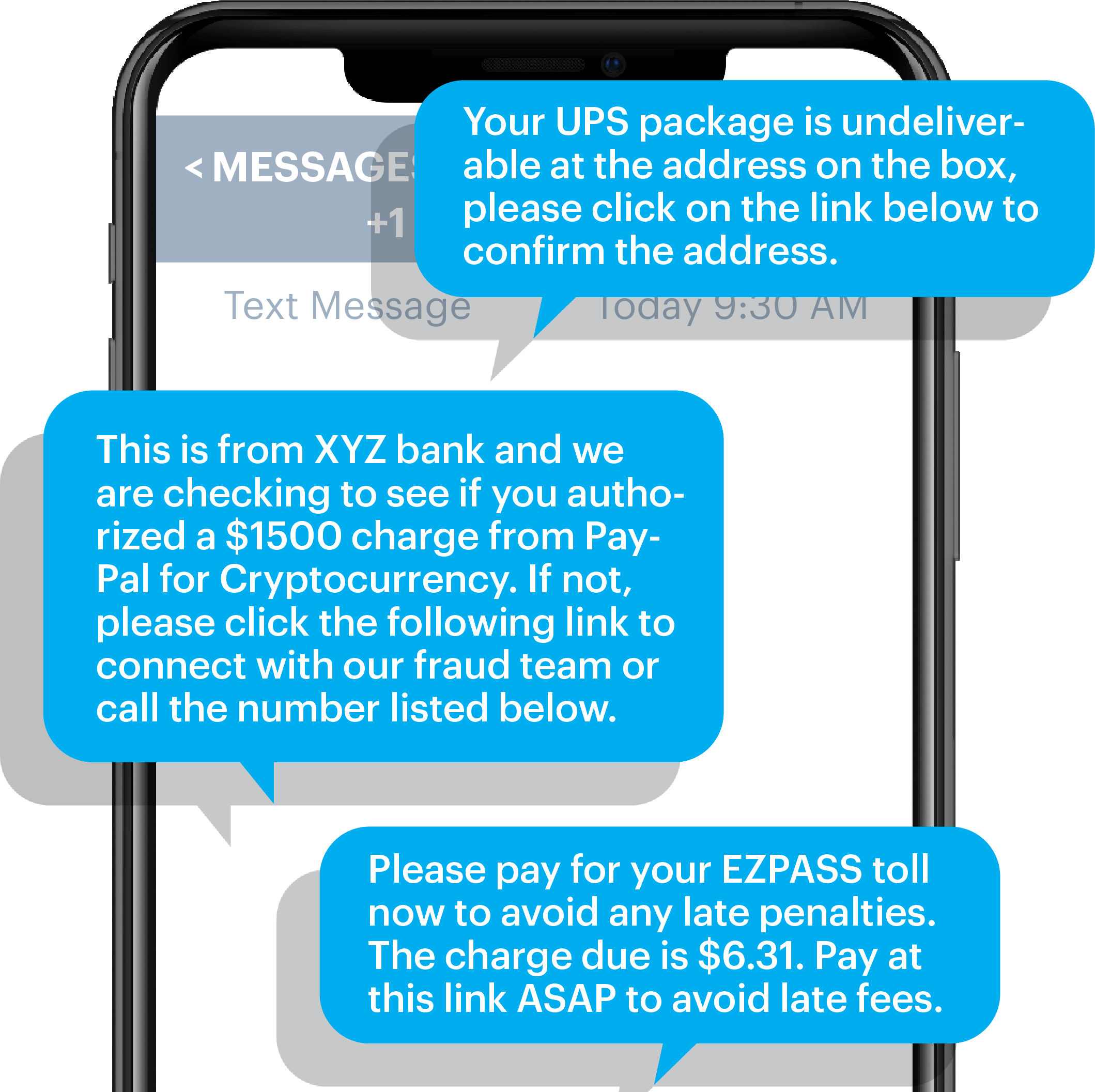Your Money: Fraud Watch
THAT TEXT MIGHT BE A TRAP!
Message scam losses are on the rise. Here’s what to know and how to protect yourself
BY SARI HARRAR

Back on the job market after a long hospital stay, Hamilton Roberts,* 69, got a text message last November offering him a $30-an-hour, work-from-home customer service position.
But it was a scam that cost him $15,000.
“The scammers said they were from a real company,” says Roberts, a data analyst from the Washington, D.C., area. “They mailed me checks for ordering equipment and had me send some money back to them. But the checks were bad. I lost my savings.”
Like Roberts, more and more Americans are falling victim to text message fraud. In 2024, consumers lost $470 million to these scams, five times more than in 2020, says the Federal Trade Commission. One big reason for the surge: Criminals know that while consumers are wary of unsolicited phone calls and emails, our guard is down when it comes to texts—even when the sender is unknown.
“People are more trusting with text messages,” says Murat Kantarcioglu, a computer science professor at Virginia Tech. “We’re used to getting them from friends and family.”
We’re also used to displaying good manners by responding quickly, notes Aimee Larsen Kirkpatrick, president of the STOP. THINK. CONNECT. Messaging Convention, a global digital security campaign.
“Criminals know consumers open 98 percent of text messages and respond to 45 percent, while we open just 20 percent of emails and respond to 6 percent,” she says.
In February, a short text popped up on Terry Marshall’s phone. “It said, ‘Hello,’ ” recalls the 67-year-old retired electrician from Tennessee. “I answered, ‘Hello, who is this?’ I thought it was a friend. But they wrote back, ‘Oh, isn’t this Ginny?’ I said they had the wrong number and erased the conversation.”
But the mysterious texter kept on chatting, telling Marshall he was “super nice” and sending a photo. “It was a cute girl named Isabella,” he says. “Isabella” persuaded Marshall to invest $105,000—nearly his life savings—in cryptocurrency. The money seemed to grow, then vanished. Desperate to recover his nest egg, Marshall lost another $11,000 to a scam-recovery company that was also a fraud. He reported the scams to police and the FBI.
Losses go beyond money. Criminals are stealing personal information, including passwords and credit card, bank account, Medicare and Social Security numbers.
“These are pros,” says Bradley Reaves, an associate professor at North Carolina State University, who studies text and robocall scams. “It is organized crime.”
And they’re using a stunning variety of text message scams. Topping the list in a 2025 FTC report were text frauds involving phony package delivery problems, sham job offers, bogus fraud alerts for items consumers never purchased and wrong number texts like the one Marshall fell for. Text scammers also impersonate banks, credit card companies, computer tech-support services, Social Security, the IRS and Medicare.
That’s not all. Toll road agencies across the U.S. are warning the public about a rash of texts claiming recipients owe highway tolls and face big fees or legal action.
“I got a text that I owed $6.99 in tolls on the Massachusetts Turnpike,” says Douglas Johnson, 80, a retired printer from North Carolina. “My wife and I had been traveling in Massachusetts, so I thought maybe it was true. I started entering my credit card information when I realized something wasn’t right.”
Johnson, who taught cybersecurity safety programs to older adults for years, says, “If you have any question in your mind about a text, just delete it.”
*The names in this story were changed on request to prevent follow-up scam attempts.
Sari Harrar is a contributing editor at AARP who writes frequently about health and fraud.
5 Ways to Thwart a Text Scam
Amy Nofziger, director of the AARP Fraud Watch Network Helpline, says, “There isn’t an hour that goes by we don’t hear from another text scam victim.”
Here’s her advice on how you can avoid getting scammed.
▶︎ Filter unknown numbers. Set up your phone to filter texts from numbers not in your contacts list. Block suspicious ones.
▶︎ Read carefully and slowly. If a text urges quick action, it’s likely a scam.
▶︎ Don’t respond. Ignore texts from unknown numbers. Legitimate senders will find other ways to reach you.
▶︎ Verify numbers. If a text asks you to call a bank or other company, look up the number. If you use the phone number in a scam text, you could be dialing straight into the scammer’s call center.
▶︎ Beware of red flags. Do they want you to call a number or click on a link, or are they saying you owe money? Those are all huge signs of a scam. And if the word “crypto” is mentioned, delete and block!
Got questions about scams or need to report fraud? Call the AARP Fraud Watch Network Helpline toll-free at 877-908-3360. Visit aarp.org/fraudwatchnetwork for the latest fraud alerts, news and tips.
AARP (Getty Images)